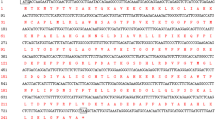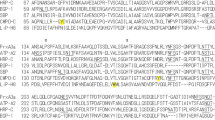Abstract
The present study reported for the first time, cloning, expression and characteristics of a Proxidomal APX gene (PpAPX) from Populus tomentosa. The PpAPX gene encodes a protein of 287 amino acid residues with a calculated molecular mass of 31.58 kDa. The over-expressed recombinant PpAPX protein showed high activity towards the substrates ascorbate aicd (ASA) and H2O2. At fixed ASA concentrations, the K m and V max values were 0.12 ± 0.01 mM and 23.4 ± 4.2 mmol/min mg for H2O2. And at fixed H2O2 concentrations, the K m and V max values were 0.53 ± 0.04 mM and 20.0 ± 2.3 mmol/min mg for ASA.






Similar content being viewed by others
References
D’Arcy-Lameta A, Ferrari RY, Contour-ansel DC et al (2006) Isolation and characterization of four ascorbate peroxidase cDNAs responsive to water deficit in cowpea leaves. Ann Bot 97(1):133–140
Asada K (1988) Ascorbate-peroxidase; scavenging system of hydrogen peroxide in chloroplasts. Tanpakushitsu Kakusan Koso 33(16):2957–2964
Storozhenko S, Pauw PD, Montagu MV (1998) The heat-shock element is a functional component of the Arabidopsis APX1 gene promoter. Plant Physiol 118(3):1005–1014
Mittler R, Zilinskas BA (1994) Regulation of pea cytosolic ascorbate peroxidase and other antioxidant enzymes during the progression of drought stress and following recovery from drought. Plant J 5(3):397–405
Shigeoka SI, Tamoi T, Miyagawa M et al (2002) Regulation and function of ascorbate peroxidase isoenzymes. J Exp Bot 53(372):1305–1319
Chatfield M, Dalton DA (1993) Ascorbate peroxidase from soybean root nodules. Plant Physiol 103(2):661–662
Mittler R, Zilinskas BA (1992) Molecular cloning and characterization of a gene encoding pea cytosolic ascorbate peroxidase. J Biol Chem 267(30):21802–21807
Kubo AS, Tanaka H, Kondo K (1992) Cloning and sequencing of a cDNA encoding ascorbate peroxidase from Arabidopsis thaliana. Plant Mol Biol 18(4):691–701
Dalton DA, Kahn L, Joyner ML et al (1996) Heterologous expression and characterization of soybean cytosolic ascorbate peroxidase. Arch Biochem Biophys 328(1):1–8
Patterson WR, Poulos TL (1995) Crystal structure of recombinant pea cytosolic ascorbate peroxidase. Biochemistry 34(13):4331–4341
Ishikawa TY, Sakai K, Tamoi K et al (1998) Molecular characterization and physiological role of a glyoxysome-bound ascorbate peroxidase from spinach. Plant Cell Physiol 39(1):23–34
Bunkelmann JR, Trelease RN (1996) Ascorbate peroxidase. A prominent membrane protein in oilseed glyoxysomes. Plant Physiol 110(2):589–598
Teixeira FK, Margis L, Margis-Pinheiro R (2004) Analysis of the molecular evolutionary history of the ascorbate peroxidase gene family: inferences from the rice genome. J Mol Evol 59(6):761–770
Panchuk II, Zentgraf U, Volkov RA (2005) Expression of the Apx gene family during leaf senescence of Arabidopsis thaliana. Planta 222(5):926–932
Lu H, Zhao YL, Jiang XN (2004) Stable and specific expression of 4-coumarate: coenzyme A ligase gene (4CL1) driven by the xylem-specific Pto4CL1 promoter in the transgenic tobacco. Biotechnol Lett 26(14):1147–1152
Ruiz-Duenas FJ, Martinez MJ, Martinez AT (2006) In vitro activation, purification, and characterization of Escherichia coli expressed aryl-alcohol oxidase, a unique H2O2-producing enzyme. Protein Expr Purif 45(1):191–199
Lu ZQ, Takano T, Liu SK (2005) Purification and characterization of two ascorbate peroxidases of rice (Oryza sativa L.) expressed in Escherichia coli. Biotechnol Lett 27(1):63–67
Kelly GJ, Latzko E (1979) Soluble ascorbate peroxidase: detection in plants and use in vitamim C estimation. Naturwissenschaften 66(12):617–619
Schwede T, Kopp J, Guex N et al (2003) SWISS-MODEL: an automated protein homology-modeling sever. Nucleic Acids Res 31:3381–3385
Kim IJ, Chung WI (1998) Isolation of genomic DNA containing a cytosolic ascorbate peroxidase gene (ApxSC) from the strawberry (Fragaria × ananassa). Biosci Biotechnol Biochem 62(7):1358–1363
Ishikawa TS, Yoshimura K, Takeda K (1996) cDNAs encoding spinach stromal and thylakoid-bound ascorbate peroxidase, differing in the presence or absence of their 3’-coding regions. FEBS Lett 384(3):289–293
Mullen RT, Trelease RN (2000) The sorting signals for peroxisomal membrane-bound ascorbate peroxidase are within its C-terminal tail. J Biol Chem 275(21):16337–16344
Celik A, Cullis PM, Raven EL (2000) Catalytic oxidation of p-cresol by ascorbate peroxidase. Arch Biochem Biophys 373(1):175–181
Ishikawa T, Sakai K, Yoshimura K et al (1996) cDNAs encoding spinach stromal and thylakoid-bound ascorbate peroxidase, differing in the presence or absence of their 3′-coding regions. FEBS Lett 384(3):289–293
Yoshimura K, Ishikawa T, Nakamura Y et al (1998) Comparative study on recombinant chloroplastic and cytosolic ascorbate peroxidase isozymes of spinach. Arich Biochem Biophys 353(1):55–63
Murgia I, Tarantino D, Vannini C et al (2004) Arabidopsis thaliana plants overexpressing thylakoidal ascorbate peroxidase show increased resistance to Paraquat-induced photooxidative stress and to nitric oxide-induced cell death. Plant J 38(6):940–953
Acknowledgements
This work was jointly supported by the Key Project of Chinese Ministry of Education (no. 106039).
Author information
Authors and Affiliations
Corresponding author
Rights and permissions
About this article
Cite this article
Lu, H., Han, RL. & Jiang, XN. Heterologous expression and characterization of a proxidomal ascorbate peroxidase from Populus tomentosa . Mol Biol Rep 36, 21–27 (2009). https://doi.org/10.1007/s11033-007-9147-6
Received:
Accepted:
Published:
Issue Date:
DOI: https://doi.org/10.1007/s11033-007-9147-6




